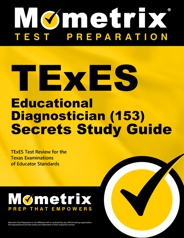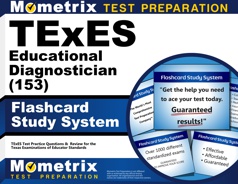The TExES Educational Diagnostician exam is an assessment test designed to test the knowledge of entry-level educational diagnosticians in the state of Texas.
Click “Start Test” above to take a free TExES Educational Diagnostician practice test, and check out our premium-quality TExES test prep resources by clicking the links below!
Exam Outline
The TExES Educational Diagnostician exam contains a total of 90 selected-response questions and one constructed-response question, and you will be given 4 hours and 45 minutes to complete it.
Teaching Standards
The TExES Educational Diagnostician exam is aligned with the 10 standards for educators that have been outlined by the State Board for Educator Certification.
Click the button below to see the full list of approved educator standards:
Approved Educator Standards
Standard I: You are expected to understand the purpose, philosophy, and legal foundations of evaluation and special education.
Standard II: You are expected to understand ethical and professional practices, roles, and responsibilities.
Standard III: You are expected to develop collaborative relationships with families, educators, the school, the community, outside agencies, and related service personnel.
Standard IV: You are expected to understand student assessment and evaluation, program planning, and instructional decision-making.
Standard V: You are expected to understand eligibility criteria and procedures for identifying students with disabilities and determining the presence of an educational need.
Standard VI: You are expected to select, administer, and interpret appropriate formal and informal assessments and evaluations.
Standard VII: You are expected to understand ethnic, linguistic, cultural, and socioeconomic diversity and the significance of student diversity for evaluation, planning, and instruction.
Standard VIII: You are expected to understand scheduling, time management, and organization.
Standard IX: You are expected to address students’ behavioral and social interaction skills through appropriate assessment, evaluation, planning, and instructional strategies.
Standard X: You are expected to understand appropriate curricula and instructional strategies for individuals with disabilities.
Exam Domains
The exam is split into four domains, each of which covers multiple standards mentioned above.
| Domain | Percentage of Exam | Standards Used |
|---|---|---|
| 1. Identification and Assessment | 34% | I, III-V/II, and X |
| 2. Curriculum, Instruction, and Intervention | 23% | IV-VII, IX, and X |
| 3. Professional Responsibilities | 23% | I-IV and VIII |
| 4. Analysis and Response | 20% | II, IV-VI and X |
1. Identification and Assessment (34%)
For the questions in this domain, you will be tested on your knowledge and abilities in the following areas:
- Identification for special education evaluation and services
- Evaluation, planning, selection, and administration
- Interpretation and reporting of evaluation results
2. Curriculum, Instruction, and Intervention (23%)
For the questions in this domain, you will be tested on your knowledge and abilities in the following areas:
- Academic instruction and strategies
- Functional skill instruction and strategies
3. Professional Responsibilities (23%)
For the questions in this domain, you will be tested on your knowledge and abilities in the following areas:
- Consultation and collaboration
- Legal and ethical practice
4. Analysis and Response (20%)
For the questions in this domain, you will be asked to provide a written response that analyzes qualitative and quantitative data, provides a thorough evaluation, and determines recommendations for meeting a student’s educational needs.
Check Out Mometrix's TExES Educational Diagnostician Study Guide
Get practice questions, video tutorials, and detailed study lessons
Get Your Study Guide
Registration
To register for the exam, you must create an online NES account via their website. Once your account has been created, you can use it to register for the exam and schedule an exam date. When you register, you will need to pay the $200 examination fee.
Test Day
On exam day, you should arrive at the testing center 30 minutes early on the day of your testing appointment. Upon arrival, you will be asked to sign in and provide at least one form of valid photo ID.
After the check-in process is complete, you will be asked to leave all personal items (cell phone, keys, wallet, etc.) in a locker outside the testing area.
Once you enter the testing room, you will be given a brief tutorial on the computer-adaptive testing system before the exam begins.
How the Exam is Scored
The TExES Educational Diagnostician exam is computer-adaptive. Here’s a look at how it works:
The first question is judged to be of medium difficulty, and depending on your performance, the next question may be easier or harder. If you do well on the first question, the second question will be harder; conversely, if you do poorly on the first question, the second question will be easy.
The questions on this exam are rated on a scale of 100-300. The higher a question is rated, the harder the question is (e.g., a question marked as 220 will be more difficult than a question marked 120).
To pass the exam, your final question must be on or above the 240 mark. If your final question is below this mark, you will not pass the exam, even if you have answered some questions above the 240 mark at some point during the exam. This is because the computer has rated the difficulty of your final question based on how you answered the previous questions.
Check Out Mometrix's TExES Educational Diagnostician Flashcards
Get complex subjects broken down into easily understandable concepts
Get Your Flashcards
FAQs
Q
How many questions are on the TExES Educational Diagnostician exam?
A
There are 90 selected-response questions and one constructed-response question on the exam.
Q
How long is the TExES Educational Diagnostician exam?
A
The time limit for this exam is 4 hours and 45 minutes.
Q
What is the passing score for the TExES Educational Diagnostician exam?
A
To pass the exam, you must achieve a scaled score of at least 240.
Q
How much does the TExES Educational Diagnostician exam cost?
A
The examination fee is $200.
function toggle(obj) {
var obj=document.getElementById(obj);
if (obj.style.display == “block”) obj.style.display = “none”;
else obj.style.display = “block”;
}


